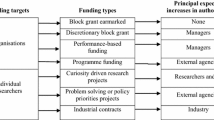Abstract
The relationships between funding heterogeneity and organisational structure and functioning were examined for a panel of non-profit organisations. Resource dependence and institutional theory were used to derive hypotheses predicting positive associations between funding heterogeneity and non-profit boundary spanning, modelling and participation in collective efforts. For non-profits which were less vulnerable to institutional aspects of their environments, funding heterogeneity was found to have a positive effect on boundary spanning, consistent with resource dependence theory. For non-profits which were more vulnerable to institutional factors, on the other hand, funding heterogeneity was found to have positive effects on modelling and participation in collective efforts; consistent with institutional theory. These results argue that resource dependence and institutional theory need to be combined for the analysis of organisation-environment relations and suggest how this could be accomplished.
Similar content being viewed by others
References
Aldrich, H.E. (1979)Organizations and Environments, Prentice-Hall, Englewood Cliffs, New Jersey.
Chronicle of Philanthropy (1992) The non-profit world: a statistical profile, 28 January, 24–5.
DiMaggio, P.J. and Powell, W.W. (1983) The iron cage revisited: institutional isomorphism and collective rationality in organizational fields,American Sociological Review, 48, 147–60.
Galaskiewicz, J. and Shatin, D. (1981) Leadership and networking among neighborhood human service agencies,Administrative Sciences Quarterly, 26, 434–48.
Galbraith, J. (1977)Organizational Design, Addison-Wesley, Reading, Massachusetts.
Granovetter, M. (1985) Economic action and social structure: the problem of embeddedness,American Journal of Sociology, 91, 481–510.
Hall, P.D. (1987) A historical overview of the nonprofit sector, in W.W. Powell (ed.)The Nonprofit Sector, Yale University Press, New Haven, Connecticut.
Hannan, M.T. and Freeman, J. (1988)Organizational Ecology, Harvard University Press, Cambridge, Massachusetts.
Internal Revenue Service (1988)Tax Exempt Status for Your Organization, Publication 557, US Government Printing Office, Washington, DC.
Internal Revenue Service (1986)Application for Recognition of Exemption Under Section 501(c)(3) of the Internal Revenue Code, Package 1023, Revision 3–86, US Government Printing Office, Washington, DC.
Internal Revenue Service (1979)Cumulative List of Organizations, US Government Printing Office, Washington, DC.
Lawrence, P.R. and Lorsch, J.W. (1967)Organization and Environment: Managing Differentiation and Integration, Graduate School of Business Administration, Harvard University, Boston, Massachusetts.
Lindblom, C.E. (1977)Politics and Markets, Basic Books, New York.
Meyer, J.W. and Scott, W.R. (1983)Organizational Environments, Sage, Beverly Hills, California.
Meyer, J.W. and Rowan, B. (1977) Institutionalized organizations: formal structure as myth and ceremony,American Journal of Sociology, 83, 440–63.
Nelson, R. and Winter, S. (1982)An Evolutionary Theory of Economic Change, Harvard University Press, Cambridge, Massachusetts.
Pfeffer, J. (1982)Organizations and Organization Theory, Pitman, Boston.
Pfeffer, J. and Salancik, G.R. (1978)The External Control of Organizations: A Resource Dependency Perspective, Harper and Row, New York.
Powell, W.W. (1991) Expanding the scope of institutional arguments, in W.W. Powell and P. DiMaggio (eds)The New Institutionalization in Organizational Analysis, University of Chicago Press, Chicago, Illinois.
Roy, W. (1990) Functional and historical logics in explaining the rise of the American industrial corporation,Comparative Social Research, 12, 19–44.
Scott, W.R. (1987)Organizations Rational, Natural, and Open Systems. 2nd edition, Prentice-Hall, Englewood Cliffs, New Jersey.
Scott, W.R. (1991) Unpacking institutional arguments, in W.W. Powell and P. DiMaggio (eds)The New Institutionalization in Organizational Analysis, University of Chicago Press, Chicago, Illinois.
Story, R. (1980)The Forging of an Aristocracy, Wesleyan University Press, Middletown, Connecticut.
Thompson, J. (1967)Organizations in Action, McGraw Hill, New York.
Tolbert, P.S. (1985) Institutional environments and resource dependence: sources of administrative structure in institutions of higher education,Administrative Science Quarterly, 30, 1–13.
Tolbert, P. and Zucker, L. (1983) Institutional sources of change in organizational structure: the diffusion of civil service reform, 1880–1935,Administrative Science Quarterly, 28, 22–39.
Zucker, L. (1983) Organizations as institutions, in S.B. Bacharach (ed.)Research in the Sociology of Organizations, Vol. 2. JAI Press, Greenwich, Connecticut.
Author information
Authors and Affiliations
Additional information
The research described in this article was sponsored by grants from the National Science Foundation, the Program on Nonprofit Organizations at Yale University, and the University of Minnesota. An earlier version of this paper was presented at the 1990 Meetings of the American Sociological Association, August 11–15, Washington, D.C.
Rights and permissions
About this article
Cite this article
Bielefeld, W. Non-profit-funding environment relations: theory and application. Voluntas 3, 48–70 (1992). https://doi.org/10.1007/BF01398026
Issue Date:
DOI: https://doi.org/10.1007/BF01398026




